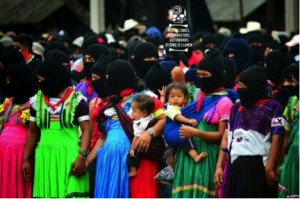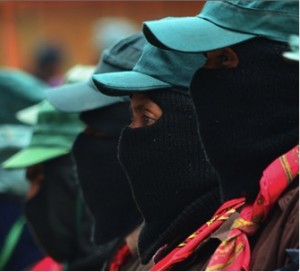 On Friday May 2, 2014 an Indigenous Zapatista teacher, Jose Luis Solís López – known by his name ‘in the struggle’ as “Compañero Galeano” – was ambushed and murdered. He was beaten with rocks and clubs, hacked with a machete, shot in the leg and chest, and as he lay on the ground gasping for air – he was executed by a final bullet to the head.
On Friday May 2, 2014 an Indigenous Zapatista teacher, Jose Luis Solís López – known by his name ‘in the struggle’ as “Compañero Galeano” – was ambushed and murdered. He was beaten with rocks and clubs, hacked with a machete, shot in the leg and chest, and as he lay on the ground gasping for air – he was executed by a final bullet to the head.
Galeano was assassinated because he was Indigenous, because he was a teacher, because he was poor, and more specifically – because he was a Zapatista. And in a contemporary global system of neoliberal production and colonial governance, people like Galeano are deemed to be threats – threats liable to be killed in cold blood.
The assault on Galeano was also an attempt to antagonize the EZLN (Zapatista Army of National Liberation) into reacting with violence as retribution for the death of one of their promotores de educación (‘promoters of education’ – what teachers are called in the Zapatista system of horizontal education). The provocation was directly aimed at the EZLN in hopes of prompting them into engaging in armed conflict, which would thereby give the Mexican government reason to retaliate and attack Zapatista communities.
However, despite the pain and rage that the Zapatistas feel, their statements call for peace. And amidst the tears, sorrow, indignation, and sadness atone of their cherished teachers being slain in broad daylight, they have stated they are not seeking revenge, blood, or vengeance, but rather, they seek justice.
Instead, the murder of Galeano has galvanized a re-organization within the ranks of the Zapatistas and a renewed international solidarity movement. The exit of Subcomandante Marcos as such and the formation of an international Civil Peace camp are signs of a new cycle in building indigenous autonomy (more below).
‘La Realidad’ – The Reality
Galeano was viciously murdered by nearly 20 members of differing paramilitary organizations in La Realidad (‘The Reality’), a Zapatista Caracol located in the Lacandon Jungle of Chiapas, Mexico. Once dead, the attackers (who are not part of the Mexican military or government but are paid under-the-table and given kickbacks for their attempts at fracturing Zapatista communities[1]) drug his body nearly 100 yards, dropped it on the ground, and left it.. Several Zapatista women, widely recognized for their fearlessness, courage, and dignity, went out under the face of further threat to carry Galeano’s body back to shelter.
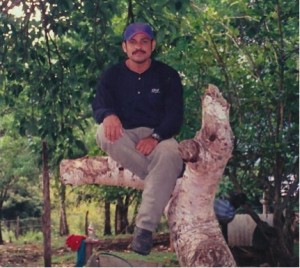 In the attack on Galeano, the paramilitaries injured 15 other unarmed Indigenous Zapatistas, and set about destroying a local school, health clinic, and water system. The attack has been identified by peace observers from the Fray Bartolomé de las Casas Human Rights Center as a premeditated act of unprovoked aggression. Given the history of paramilitary activity in the region, and the account of a young Zapatista woman who was later verbally taunted, mocked, and bullied by the shooter, the slaying of Galeano can be seen as part of a larger strategy of low-intensity warfare that the federal, state, and local levels of the Mexican government (called the ‘Bad Government’ by the Zapatistas) are waging against the EZLN and its bases of support.
In the attack on Galeano, the paramilitaries injured 15 other unarmed Indigenous Zapatistas, and set about destroying a local school, health clinic, and water system. The attack has been identified by peace observers from the Fray Bartolomé de las Casas Human Rights Center as a premeditated act of unprovoked aggression. Given the history of paramilitary activity in the region, and the account of a young Zapatista woman who was later verbally taunted, mocked, and bullied by the shooter, the slaying of Galeano can be seen as part of a larger strategy of low-intensity warfare that the federal, state, and local levels of the Mexican government (called the ‘Bad Government’ by the Zapatistas) are waging against the EZLN and its bases of support.
The underlying motivations of Galeano’s death, the state-sanctioned counterinsurgency, and the militarized surveillance of Indigenous Zapatista communities are complex and multifaceted. The assassination was not the result of a single, isolated incident. Galeano’s murder is part of an ongoing story of over 500 years of imperial conquest, the racist denigration of Indigenous people, the repression of rural peasants, and exploitative processes of accumulation by dispossession. Such socio-political dynamics not only continue to operate within Mexico, but they also remain part of an alienating status quo that continues to operate around the entire globe.
Indigenous Autonomy
The primary reason that Galeano and the other Zapatistas were targeted is because they are living a life of decolonial, anti-capitalist, collective resistance. A life that focuses on mutual aid, equitable gender relations, autonomous education, and horizontal decision-making: A life that values shared laughter, dancing, and caring for one another. During a time in which unimpeded capitalistic production, the rampant extraction of natural resources, the attainment of individual status, and unequal systems of patriarchal governance continue to be enabled and rewarded, living a life that rejects those things is something that hierarchical power sees fit to punish.
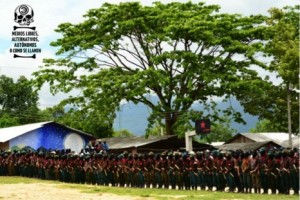 The Zapatistas suffered this violent attack because they are exercising sovereignty as Indigenous people in the face of an omniscient neoliberal industrial complex. This system of domination is driven by individualistic notions of competition, private ownership, and ambition. The Zapatistas are a threat because they collectively choose to challenge the abusive structure of negligence that neoliberalism proves to be. At this given moment, the success of the Zapatistas in contesting and opposing the ideals of neoliberalism has caused reactionary violence on the part of the colonial government.
The Zapatistas suffered this violent attack because they are exercising sovereignty as Indigenous people in the face of an omniscient neoliberal industrial complex. This system of domination is driven by individualistic notions of competition, private ownership, and ambition. The Zapatistas are a threat because they collectively choose to challenge the abusive structure of negligence that neoliberalism proves to be. At this given moment, the success of the Zapatistas in contesting and opposing the ideals of neoliberalism has caused reactionary violence on the part of the colonial government.
The responses to the victories of the Zapatistas by those who wield power and privilege have been attempts at dividing Indigenous communities and pitting them against each other. This is done through the distribution of co-optative government ‘assistance’ to anyone who will disrupt the Zapatistas and their struggle. The Zapatistas have refused to become dependent on official authorities and steadfastly refuse to accept government aid, referring to the superficial ‘aid’ packages as migajas (‘crumbs‘).
The Mexican government seeks then to discipline, humiliate, disappear, and make suffer those Indigenous rebels who have had of the audacity to reject its neoliberal edicts and shallow offerings. Consequently, military encampments and state repression have intensified in the areas where indigenous communities are based, primarily due to the democratic spaces and international solidarity that the Zapatistas have built.
Perhaps the greatest threat to the political and economic powers is the autonomy of the Zapatistas. Autonomy is dangerous because it shows agents of capitalism and the administrators of colonial domination that they are no longer necessary.
The liberation that the Zapatistas have fought for and won, along with their ability to create socially just spaces and build democracy within their own communities, continues to be subjected to heavy-handed, reactionary aggression by the neoliberal government. (A phrase on recent attacks would be good here to keep it concrete and root in current situation–most of our readers know quite a bit about the Zapatistas) This is because neoliberalism, just as ongoing colonialism, fears being exposed as incompetent, unjust and violent, and And this reality is exactly what the Zapatistas reveal.
As Subcomandante Marcos said shortly after the Zapatista uprising of 1994:
In our dream, children are children, and their work is to be children… I do not dream of the agrarian redistribution, of big mobilisations, of the fall of the government and elections, and the victory of a left-wing party, or whatever. I dream of the children, and I see them being children.
Indigenous teachers like Galeano make such dreams come true. The impact of his murder and the attack on the Zapatista community of La Realidad are not only felt in the mountains of southeast Mexico, but they are resonating across borders. The killing of Galeano brings to the fore the underlying currents of colonial hostility, masculine dominance, and neoliberal victimization that serve as the foundation of so many peoples’ everyday lives throughout the world.
During the last part of May, thousands of Zapatistas, and their international sympathizers and supporters traveled by caravan to a remote part of the Lacandon Jungle to memorialize a murdered community member. The gathering was a way of showing respect for Galeano – for his dignified work, his modest spirit, his service as a beloved teacher and the ultimate sacrifice he had to pay.
It was also an offering of condolences to Zapatista communities and families. The homage to Galeano also saw the enigmatic and clandestine persona of Subcomandante Marcos come to an end. In the middle of a dark misty night, in the heart of a shadowy moonlit jungle fog, Subcomandante Marcos delivered his final communiqué and noted that from this point on, he would cease to exist.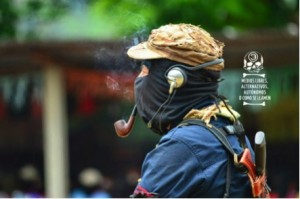
Much will be written, reported on, and said about the ‘passing’ of Subcomandante Marcos, but Subcomandante Marcos urged the attentive crowd to focus on Galeano and going forward.
The Zapatistas are moving forward. They go forward toward their dreams, children, democracy, liberty, justice, and ‘creating a world where many worlds fit’. And they do so remembering one of their own–a humble, indigenous teacher called Galeano, who despite having to die for being so, will never be forgotten. And although neoliberalism and colonial governance will continue to inflict anguish, trauma, and suffering upon the Zapatistas and countless other indigenous communities throughout the world, in the words of Zapatistas themselves: ‘La Lucha Sigue…’
Levi Gahman studies geography, feminism, and decolonial praxis at The Centre for Social, Spatial, and Economic Justice in the unceded Syilx Territory of the Okanagan Valley (British Columbia, Canada). He has contributed to RAMA (Red de Apoyo para Migrantes Agrícolas – http://ramaokanagan.org/) and is currently living in the Highlands of Chiapas while working for the open access journal – ACME: An International E-Journal for Critical Geographies (http://www.acme-journal.org/Home.html).
TAKE ACTION:
1. Donate to the Effort to Rebuild La Realidad:
There has been a bank account opened by Red Contra la Represión por la Solidaridad (RvsR) (Network Against Repression and for Solidarity) in the name of Fernanda Navarro. You can desposit contributions there to support the campaign for the reconstruction of the school and clinic in La Realidad, destroyed in the paramilitary attack last May.
Account number: 0237595986
Routing number: 072180002375959868
Name: FERNANDA SILVIA NAVARRO Y SOLARES
Bank: BANORTE
2. To Participate in a Civil Peace Camp as a Human Rights Observer:
The EZLN has recently announced that a Civil Peace Camp has been installed in the caracol of La Realidad. To assist in maintaining and rebuilding the recently attacked community. The camp is being set up in accordance with the self-determination of Indigenous people and is an effort to ensure that no further human rights violations occur. Members of national and international civil society have also kindly been encouraged to participate, and anyone interested in supporting the Zapatistas by becoming a peace observer is welcome to contact the Fray Bartolomé Human Rights Center at: bricos@frayba.org.mx
Requirements for participation in the Peace Camp in La Realidad are:
1. A letter of endorsement and confirmation of preparedness from an organization in solidarity.
2. The ability to speak Spanish fluently.
3. A minimum availability of one week to stay in a community.
4. Over the age of 18.
5. A photocopy of the following documents:
– If you are from Mexico: electoral or school credentials or current driving license.
– If you are an international observer: passport and valid visa.
6. A current photo.
7. Complete the registration form for participants. (Provided on arrival)
8. Attend preparatory workshops held by the coordinators (Details will be provided upon arrival)
NOTES:
[1]Eber, C., & Kovic, C. (eds.) (2013). Women of Chiapas: Making History in Times of Struggle and Hope. Routledge.
Photos shared courtesy of the compañer@s in the Medios Libres, Alternativos, Autónomous, o Como Se Llamen.

